From the chilling “Anguished Man” to the work of John Wayne Gacy, these supposedly haunted paintings and the circumstances surrounding their creation are enough to send shivers down your spine.
Art is a reflection of the soul, but could an artist put too much of their self into a piece? Or worse yet, could something else attach itself to a work of art? Whether you believe in ghosts or not, there are certain pieces of art that simply evoke an eerie, dreadful feeling. Perhaps, some might say, these paintings are truly haunted.
From the mysterious painting The Anguished Man to the works of serial killer John Wayne Gacy, the stories behind these allegedly cursed paintings are excellent fodder for a dark and stormy night — and the pieces themselves are quite creepy, too.
Read on to learn all about these reportedly haunted paintings and the stories behind them.
Just don’t stare for too long.
The Hands Resist Him: The Haunted Painting That Moves When You Look Away
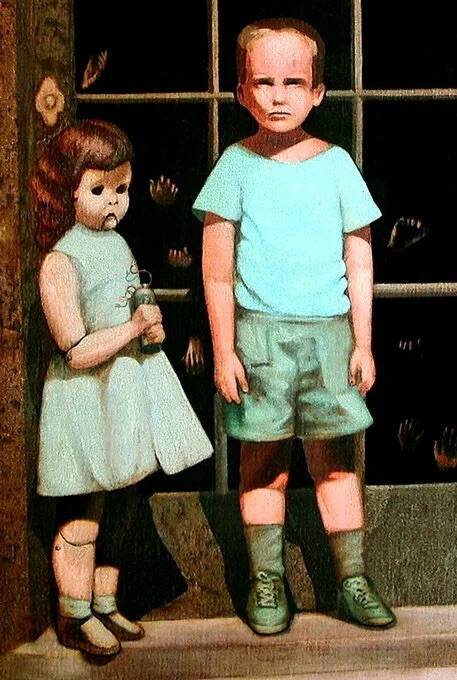
Bill Stoneham. The figures depicted in The Hands Resist Him allegedly move and even leave the painting at night.
From first glance, it’s clear there is something deeply disturbing about William Stoneham’s 1972 work, The Hands Resist Him. The painting depicts a young boy stood next to an eerily lifelike doll with a downturned mouth. Behind him, in the darkness beyond the glass door, the hands of children reach for him.
The art is terrifying enough on its own, but the alleged hauntings that plagued its owners make the eerie painting even creepier.
According to The Lineup, several prominent figures in the art world who came into contact with the painting died shortly after it was sold, including the art critic Henry Seldis and actor John Marley, who purchased the painting. Marley died in 1984, and the painting seemingly disappeared for nearly two decades.
But in 2000, it resurfaced on eBay, of all places. The new owners were looking to sell the painting as soon as possible because, they claimed, it was haunted.
Allegedly, in the middle of the night, the boy and the doll in the painting would fight, terrifying the couple’s four-year-old daughter. The sellers also claimed that they captured footage on motion-sensing cameras of the boy in the painting physically leaving the frame and stepping into the room, running away in fear.
The owners warned that those who were “faint of heart” should not bid on the painting. More than 300,000 people viewed the listing, and many reported that simply looking at the painting made them feel ill or upset.
Stoneham eventually came forward to speak about his inspiration for the painting, revealing that the boy in it was himself, that the hands in the background represented other lives, and that the doll represented his guide between two worlds. Stoneham was adopted, and the painting is meant to serve as a representation of his adoption.
He even created a sequel painting, The Hands Invent Him, which depicts the scene on the other side of the door.
The Anguished Man, A Haunted Painting From An Unknown Artist

Jules Thavenet/ArtStation. A recreation of The Anguished Man.
Often called one of the world’s most haunted paintings, the story behind The Anguished Man is like something out of a horror movie. Its current owner, Sean Robinson, detailed how he came to be in possession of this horrifying painting in an email to Dread Central.
“The Anguished Man painting was given to me by my grandmother,” he wrote. “The artist of the painting is unknown, but we do know that the artist mixed his own blood into the paint and committed suicide not long after the painting was finished… I can guarantee you that the original haunted painting is locked away in a secure location, and I have no intention of selling it.”
Robinson added that it would be “dangerous” to sell the painting, as it “is really active and really strange things happen for people who are in the same room, or even in the same house with the painting.”
Blood-infused paint and suicide are certainly excellent fodder for a haunted backstory, but what exactly are these “really strange things” Robinson mentioned?
Well, Robinson detailed these alleged hauntings on his YouTube channel, where he claimed he could hear crying and moaning noises in his house. He also claimed that he once saw “the figure of a man” stalking him.
It should be noted, however, that in 2016, rights were acquired to make a film based on the story of the painting — and without anyone else to verify Robinson’s claims about the painting’s origins and purported curse, it’s likely that this story is purely fictional.
Love Letters, The Driskill Hotel’s Haunted Painting
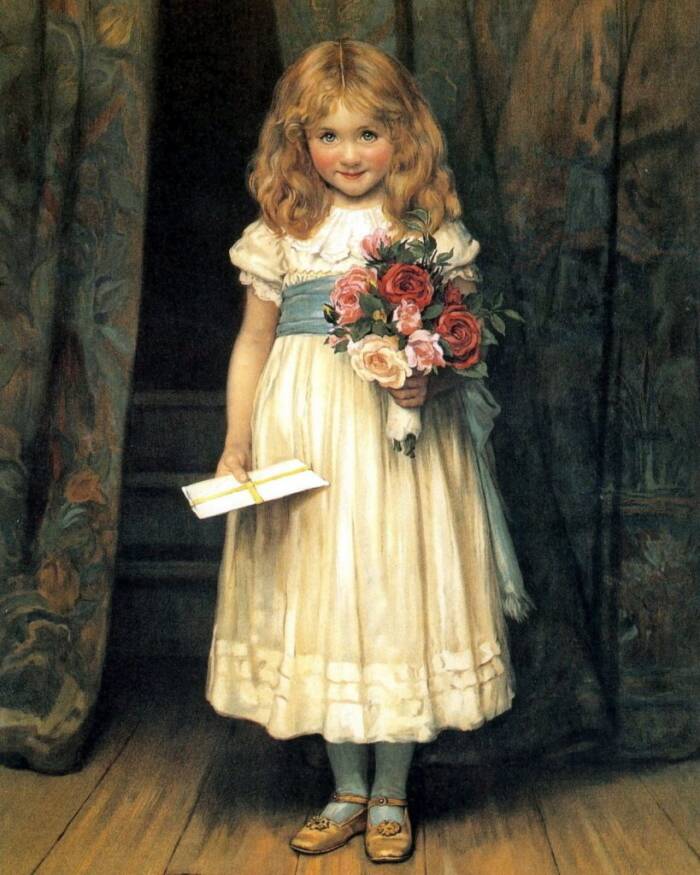
Richard King. A recreation of Love Letters.
The Driskill Hotel in Austin, Texas has a rich history. Throughout its time in operation, it has hosted presidents, rock stars, and all manner of prominent guests. There are also claims that the Driskill Hotel may have one permanent guest in the form of a ghostly little girl, but it’s not a room she is said to haunt — it’s a painting.
The painting in question is a modern replication of Charles Trevor Garland’s Love Letters, done by Richard King. The painting shows a little girl with a bouquet of flowers in one hand and a love letter in the other.
According to Texas Hill Country, the story goes that in 1887, U.S. Senator Temple Lea Houston’s four-year-old daughter Samantha tragically died at the Driskill Hotel. The young girl had been chasing after a runaway ball when she tripped and fell down the Driskill Hotel’s staircase.
She reportedly looked similar to the girl depicted in the Love Letters painting, leading paranormal enthusiasts to believe that her spirit now inhabits the painting.
Guests who visit the Driskill Hotel have claimed that they witnessed the girl’s expression change when they stare at the painting, or feeling as though the girl’s eyes were watching them move. Some have also reported feeling ill when looking at the painting, or experiencing the strange sensation of being lifted off their feet.
Of course, the girl in the painting is not Samantha Houston, and given that the artwork is a modern recreation of an older piece, it wasn’t actually around during Samantha Houston’s time.
The Crying Boy, The U.K.’s Most Haunted Painting

Giovanni Bragolin. Variations of The Crying Boy were widely popular in the U.K.
In the 1950s, artist Giovani Bragolin created a series of paintings depicting young, teary-eyed children. For some reason, mass-produced prints of these paintings proved to be incredibly successful all over the world — more than 50,000 copies of the paintings were sold in the U.K. alone.
One painting in particular, known as The Crying Boy, seemed to be followed by tragedy. In 1985, The Sun published an article called “Blazing Curse of the Crying Boy.” It detailed the experience of May and Ron Hall, whose home in Rotherham burned down. The cause of the fire was a chip pan that overheated and burst into flames, destroying nearly everything on the ground floor — except for a print of The Crying Boy.
The Halls claimed it was not a chip pan that had started the fire, but The Crying Boy himself.
Normally, such a claim would have been a one-and-done occurrence for The Sun, who frequently published tabloid news stories. In this case, though, one firefighter said that he had been at the scene of 15 different home fires where everything was destroyed. In each instance, the only thing that remained was a print of The Crying Boy.
The Sun soon published a series of articles reporting on this strange phenomenon. They claimed that a home in Surrey had burned down six months after the owner purchased a copy of The Crying Boy; a pizza restaurant in Norfolk was destroyed by a fire, leaving only a copy of the painting; and that a woman on the Isle of Wight had unsuccessfully attempted to burn her copy of The Crying Boy, after which she was plagued with terrible misfortune.
Bragolin was known to paint children from poor circumstances, so countless theories surfaced that attempted to explain why, exactly, The Crying Boy was cursed. Some claimed the boy had died in a fire, and now his spirit was trapped within the painting.
Whatever the truth may have been, The Sun certainly riled up the public’s fear around the painting, and on Halloween 1985, the newspaper gathered hundreds of copies of the painting and set them on fire.
The Stagecraft, An Allegedly Haunted Painting Based On A Photograph

Laura P. The Stagecraft was based on a photograph by James Kidd.
In 1994, commercial photographer James Kidd and an oil painter identified only as Laura P. each displayed their works at a gallery in Tombstone, Arizona. There, Kidd displayed a photograph he had taken at an old stagecoach stop in Tombstone — a double-exposure shot that bizarrely featured a figure on the left-hand side, seemingly lacking a head.
Laura was so fascinated by the photograph that she asked Kidd if she could do an oil painting of it. But as she was working on the painting, Laura began to have a strange feeling that she should not have started at all. Suddenly, odd things began to happen around her.
“I do not believe in ghosts,” she wrote for LiveAbout, “but I cannot for the life of me explain how or why these strange things have happened. I cannot attribute every one of these events directly to the painting, but they have all taken place since it has been in my house — and are totally unexplained.”
It began innocuously enough. Laura framed the painting and hung it in an office at a business location, but no matter how often the office workers straightened the painting, it would always be crooked the next morning.
Laura took the painting back, and she and her husband moved into a new home in 1995. When it rained, the roof of their garage would leak, and even though the roofers came to look at it three separate times, they could find no explanation as to why it was leaking.
That’s when Laura’s husband realized The Stagecraft had been leaning against the wall between the living room and the garage. Once they moved the painting, the leaking stopped.
Things started to ramp up, though. Objects began flying off the wall. Even people who simply looked at photographs of the painting began to experience strange things in their homes. When Laura’s neighbor borrowed the painting, he swore he saw a white, hazy figure creeping around the corners of his home.
“I still don’t actually believe in ghosts,” Laura concluded. “Yet if I had it to do over, I would not have created this painting.”
The Rain Woman, The Painting That Haunts Your Dreams
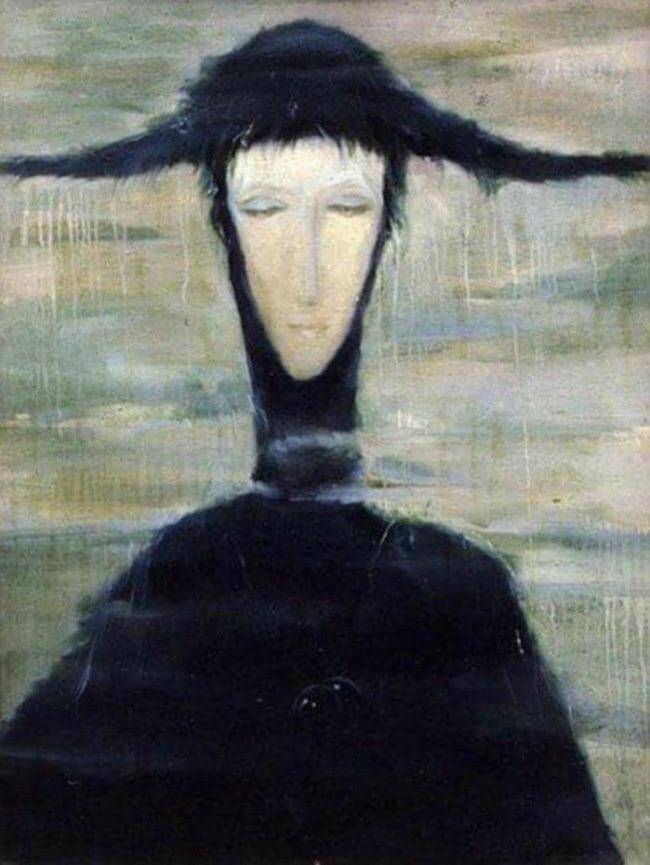
Svetlana Telets. The Rain Woman allegedly stalks the dreams of the people who own it.
Created in 1996 by Ukrainian artist Svetlana Telets, The Rain Woman is a fairly straightforward piece. It depicts, as the title suggests, a woman standing in the rain. Her features are distorted and elongated. She is dressed all in black and wears a large, wide-brimmed hat that extends to the edges of the frame.
It certainly has an eerie feeling to it, but it’s the alleged lingering effects on its owners that have led people to believe this painting may be cursed.
According to The Ghost In My Machine, there are certain people who, upon seeing The Rain Woman, feel a compulsion to purchase the painting. Those who bring the painting into their home soon begin to experience a litany of things, including insomnia, nightmares, misfortune, and the feeling of constantly being watched. In rare circumstances, owners of The Rain Woman have reported seeing or hearing someone moving about their home.
Telets herself claimed to have a strange experience with the painting. Six months before she began the painting, she told a local newspaper that she “always felt that someone was constantly watching me.” When she began work on the painting, she said she felt as if someone else were behind it, merely using her as a tool.
In total, she said it only took her “about five hours” to complete most of the work and that “it seemed like someone else was controlling my hand.”
The first buyer returned the painting to Telets, saying she could not sleep and felt like someone was in the apartment with her. The second buyer returned the painting as well, saying that the woman in the painting plagued his dreams.
“Every night, she appears and follows me like a shadow,” he said.
It was purchased in 2008 by Sergei Skachko from the band Zemlayne, who held onto it for a few years. However, his wife later got rid of the painting, as she said the two began to argue more after it came into their possession.
Death And The Child, A Chilling Creation By A Tortured Artist
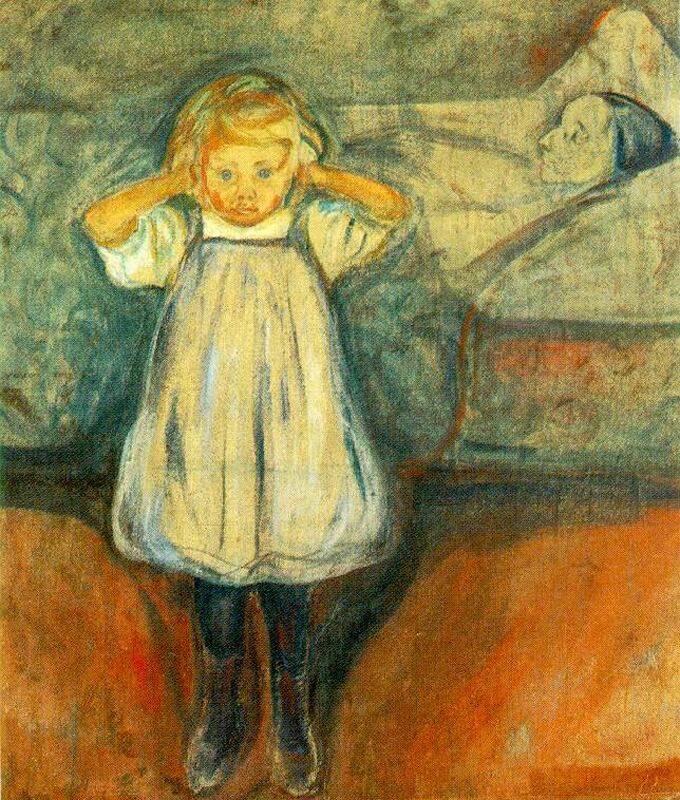
Edvard Munch. Edvar Munch’s life was filled with death ever since he was a child.
Edvard Munch is perhaps best known for his famous piece The Scream, but it is another one of his works that many people believe to be haunted. This piece, Death and the Child, depicts the tragic moment in which a young girl discovers her mother dead in a bed.
Some have claimed that the eyes of the child follow them as they move about the room. This, however, can be attributed to a fairly common painting technique. In truth, much of the reason why many consider this painting to be haunted is due to the tragic circumstances of its painter.
As Kunsthalle Bremen wrote for Google Arts & Culture, Edvard Munch had to grapple with death from a very young age. His mother passed away when he was just six years old, and his sister died a few years later. When his father died in 1889, Munch fell into a deep personal crisis.
Near the end of his life, he wrote of his childhood: “My home was the home of illness and death. I have never gotten over the calamity there. It has also influenced my art.”
The themes of death and grief are pervasive throughout Munch’s work, but Death and the Child is widely regarded to be one of his most searing portrayals of grief. The painting focuses solely on the young girl’s pain — and perhaps, for some viewers, it is simply too much to handle.
Man Proposes, God Disposes, The Painting Inspired By The Lost Franklin Expedition
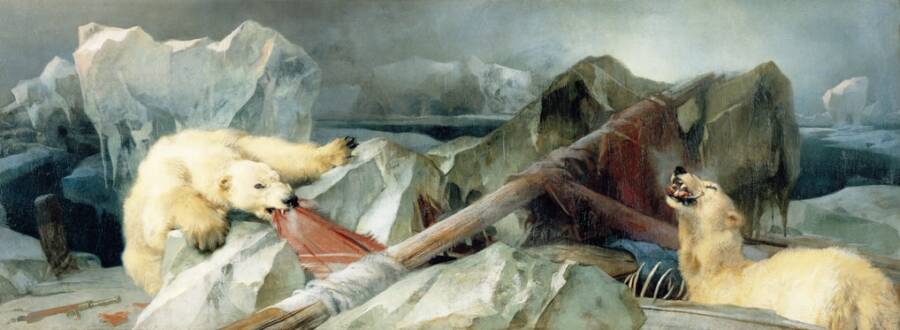
Edwin Landseer. Edwin Landseer created the painting in 1864 — just 19 years after the Franklin Expedition was lost.
Just two decades after Sir John Franklin’s expedition was lost on its way to the Northwest Passage, artist Edwin Landseer unveiled his painting Man Proposes, God Disposes, which depicts the aftermath of the lost Franklin Expedition as two polar bears tear into the crew’s remains.
Today, the painting is on display at Royal Holloway University of London, where there is a tradition of covering the painting during exams. According to the BBC, many students believe that looking at the painting during exams will cause them to fail — or possibly even drive them mad.
The superstitious practice came about due to an urban legend that claimed that in the 1970s, a student who viewed the painting felt compelled to die by suicide during her exam. Supposedly, after staring into the polar bears’ eyes, the student fell into a trance-like state of madness and etched onto her paper, “The polar bears made me do it.”
This, of course, never happened, but the urban legend spread and eventually led to the ritual of covering the painting during exams. Given that the painting itself depicts a horribly gruesome historical tragedy — and that it was completed while Sir Franklin’s wife was still alive — the piece is perfectly suited to paranormal speculation.
Pogo The Clown, A Self-Portrait By Serial Killer John Wayne Gacy
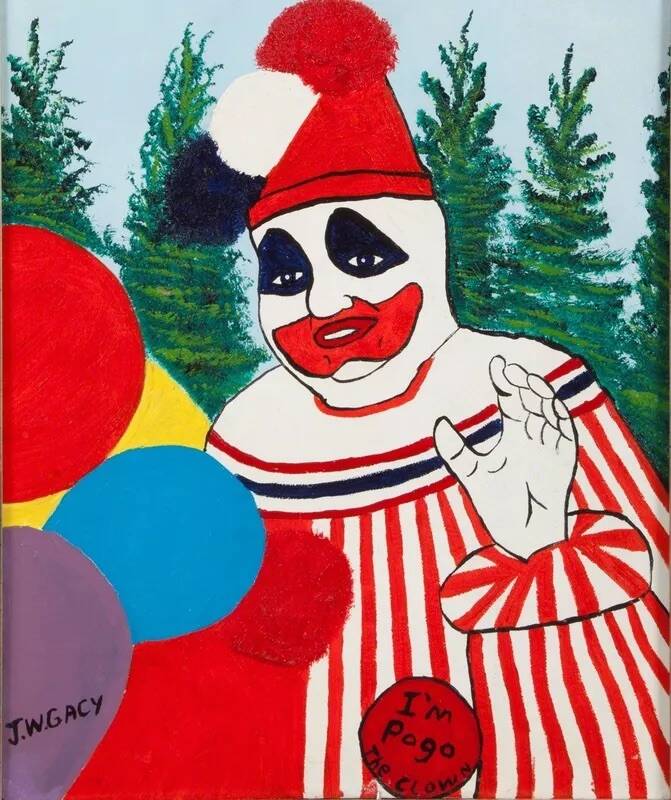
John Wayne Gacy, 1986. John Wayne Gacy raped and murdered at least 33 young men.
If any painting were to be haunted by a malevolent spirit, one created by a serial killer would fit the bill. John Wayne Gacy was one of the worst serial killers in American history, known as the “Killer Clown” due to the fact that he performed as “Pogo the Clown” during the day. At night, however, he prowled the streets of Chicago and murdered young men.
John Wayne Gacy’s first kill — which had allegedly been a mistake — gave him a “mind-numbing orgasm” that he described as “the ultimate thrill.” It began a six-year-long killing spree that left 33 young men dead, all the while Gacy was presenting himself as an upstanding member of society, performing at parties and hospitals as “Pogo the Clown.”
Gacy also created a series of paintings, ranging from images of Walt Disney’s Seven Dwarfs and portraits of Elvis to landscapes and illustrations of Jesus Christ. But none are as eerily terrifying as Gacy’s self-portrait, Pogo the Clown, which depicts him in his daytime clown costume.
The paranormally inclined, of course, believe that the spirits of particularly evil individuals can attach themselves to their belongings. In that case, the Pogo the Clown painting certainly seems to fit the bill for a potentially haunted object.
In 2001, musician Nikki Stone purchased Pogo the Clown for $3,000. Not long after the sale, however, Stone said his dog died and his mother was diagnosed with cancer — events he believed may have been connected to Gacy’s chilling painting.
Hoping to rid himself of the supposedly cursed object, Stone lent the painting to a friend to store it. That friend’s neighbor would be killed in a car crash soon afterward, and a second friend who offered to keep the painting attempted suicide.
“I just want to get rid of it,” Stone said of Pogo the Clown in 2005.
According to a report from Newsweek, the infamous self-portrait now belongs to Ghost Adventures star and paranormal investigator Zak Bagans, who owns and operates his own Haunted Museum. Alongside Gacy’s painting, Bagans owns a number of other items that once belonged to serial killers, including Jeffrey Dahmer’s glasses, Charles Manson’s hospital gown — and his bones, along with John Wayne Gacy’s brain.
